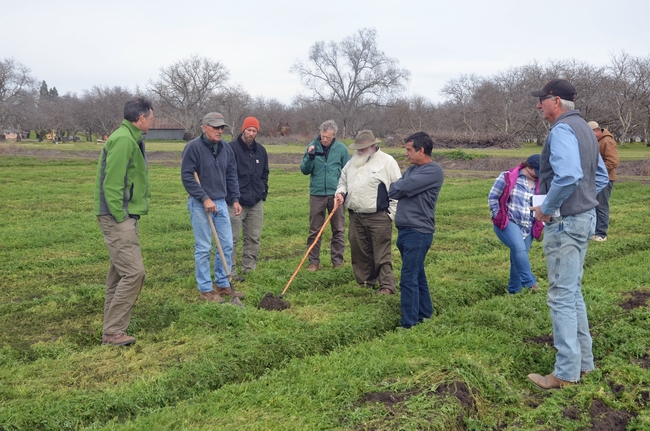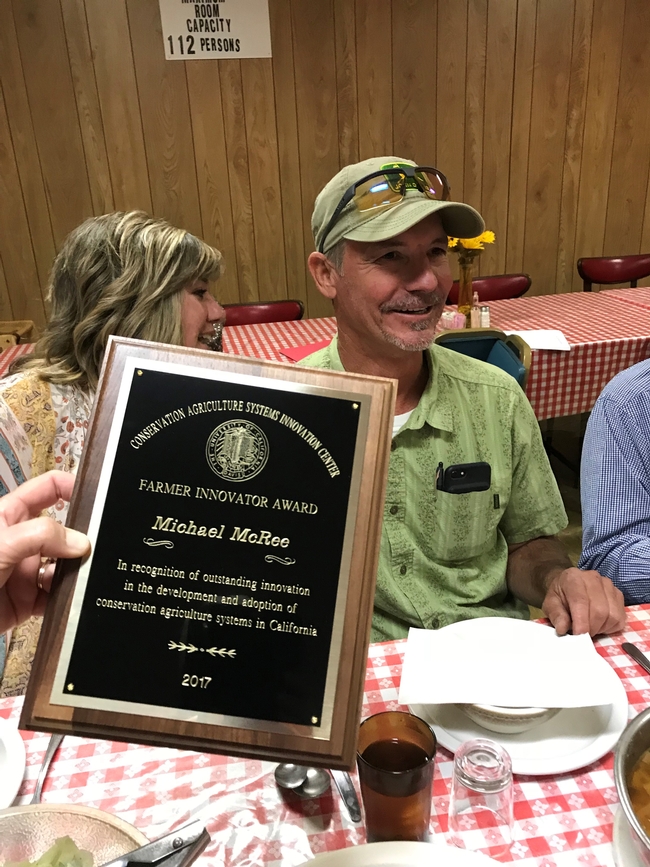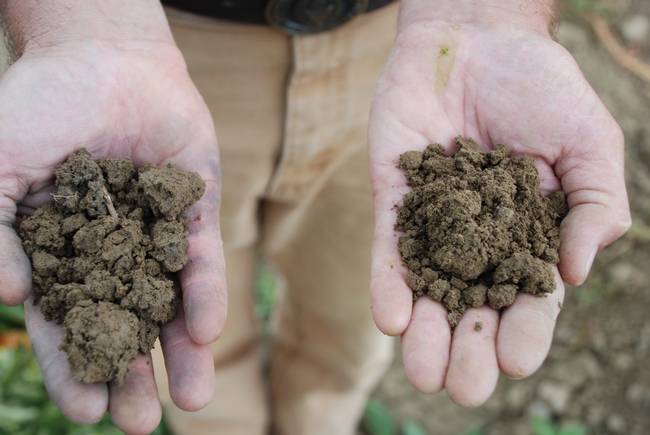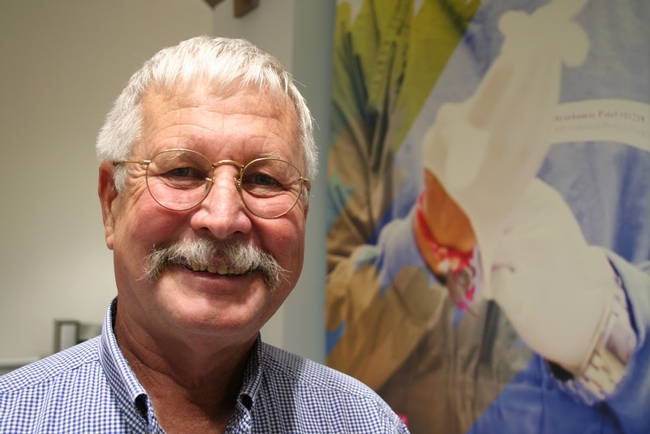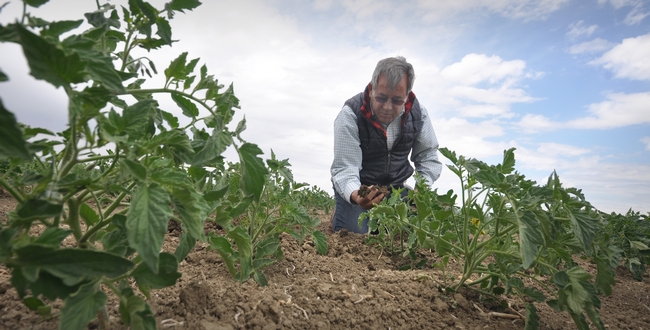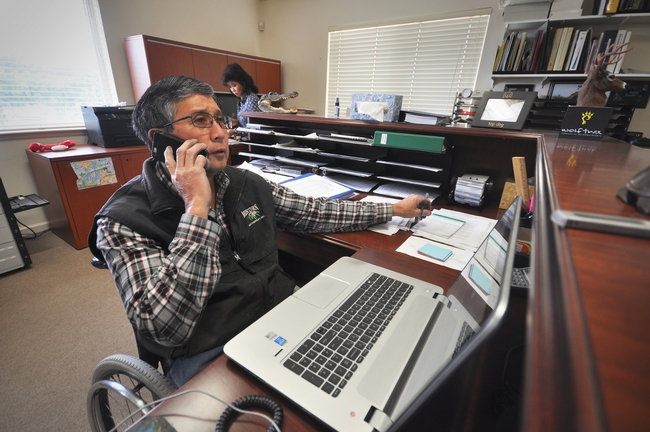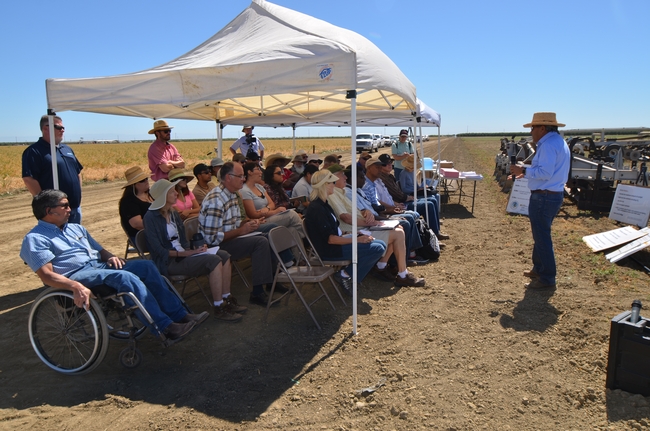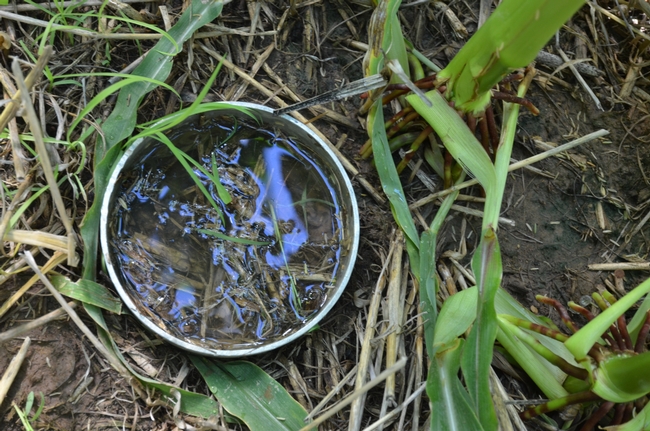Posts Tagged: CASI
University researchers and organic farmers to build soil as nature intended
A USDA grant will allow a group of California organic farmers to team up with researchers from the University of California, Chico State and Fresno State to determine whether tilling less soil on the farm will improve production of vegetable crops.
The aim is to duplicate the soil environment found in natural areas – typically concealed by plants, leaves and other organic debris – to improve agricultural soil health, increase production, reduce water use and avoid leaching nutrients out of the root zone.
“Tilling the soil is common on farms, but our research shows that it often isn't necessary, and can even be detrimental,” said Jeff Mitchell, UC Cooperative Extension agronomy specialist. “In nature, organic matter on the soil surface creates a protective layer and promotes biological activity that is beneficial to plants and the environment.”
The three-year project, funded with $380,000 from the USDA Natural Resources Conservation Service's Conservation Innovation Grant program, involves six organic farmers who are already experimenting on their own with cover crops, compost and minimum tillage to grow high-quality organic produce.
“This is a group of outstanding farmers,” Mitchell said. “It's very encouraging to see this sort of care for the soil. They recognize that taking care of the soil biology is useful to produce crops.”
One of the participants, Scott Park of Meridian, Calif., 50 miles north of Sacramento, has been building the soil on his farm for 38 years.
“We put 10 to 15 tons of biomass on every acre every year,” Park said. “This has given me good soil structure, water percolation and water retention, and we're having some really good results.”
Park said he tweaks his farming practices each year. To date, he has tinkered with reduced tillage, but isn't sold on a no-till system.
“I'm doing minimum till now, but it can be better,” Park said.
Teasing out those improvements is a goal of the project, which includes trials on four farms and two 12-acre demonstration plots, one at the UC West Side Research and Extension Center in Five Points and the other on the Chico State campus.
“Each of us will be trying to get closer to the goal of reducing tillage to promote soil health. We all want to develop strategies that might work, and not repeat mistakes,” Mitchell said.
The USDA grant funds will enable the farmers and researchers to gather accurate data about the agronomic and economic impacts of the new farming systems and use state-of-the-art equipment and technologies as they experiment with new techniques.
For example, the team is working with a Salinas company that is bringing a Spanish transplanting technology to California. The company, Tanimura & Antle Produce, will allow a demonstration of a plant tape that holds sprouts spaced ideally for a broccoli field planting in the West Side REC plot. (See video below or on YouTube at https://youtu.be/6pkmQVNjH1I .) The technology holds promise for reducing tillage, cutting back on labor, using less seed, and bringing the crop into production earlier in the season.
Planting cover crops is another way farmers and researchers will seek to improve soil health, though this process is a challenge in organic farming systems. On conventional no-till and minimum-till farms, the cover crop may be sprayed with an herbicide before planting seedlings in the cover crop residue. Possible solutions are chopping up the cover crop or using a roller-crimper machine.
“These technologies would provide considerable advantages in organic systems, but very little research has been done to quantify how these practices might influence soil function and cropping system resilience in California,” Mitchell said.
As part of the project, a farmer network will be developed for information sharing, 18 public extension events will be held, six videos will be created and curriculum will be developed to extend the research outcomes.
For more information, contact Jeff Mitchell at jpmitchell@ucanr.edu, or (559) 303-9689.
In the video below, see an overview of transplanting technology developed in Spain that will be part of the soil building research.
Chowchilla dairy farmer named 2017 Conservation Agriculture Farmer Innovator
“Mike McRee has been extremely willing to share his experiences with others and has graciously hosted numerous public field days at his dairy farm over the years,” said Jeffrey Mitchell, UC Cooperative Extension cropping systems specialist and CASI founder.
The dairy producer, who milks about 2,000 cows at his farm west of Chowchilla, double crops his own dairy forage along with tomatoes and alfalfa crops on about 850 acres. After his pioneering efforts with strip-till – some of the very earliest in the entire San Joaquin Valley – McRee soon found that the conservation agriculture practice saved him time and money as he had anticipated, and yielded other important benefits for his farm as well.
McRee noticed improved water-holding capacity of his soil since working with strip-tillage, as well as increased consistency in the soil's ability to absorb water, mellower soil overall, and more consistent crop stands and yields overall.
Improved soil tilth, increased soil organic matter and earthworms give him consistent yields year to year without extreme highs or lows.
McRee's quest to improve the performance of his silage production systems began back in 2007.
He readily admits that he faced challenges early on.
He tried no-till wheat, but was limited in this effort by hard, compacted soils. Having the right equipment is a key to the whole endeavor, McRee points out.
He has worked with local NRCS partners and the EQIP program, which assists growers with implementation of practices to improve our soil, water and air resources.
Following a great deal of consultation with other growers and experimentation, he developed a very successful strip-tillage system for his silage corps. The change was spurred initially by his interest in reducing the number of times he had to drive a tractor through his fields to save fuel and labor.
He now does fall primary tillage using a Wilcox 7-shank subsoil ripper with a crumbler. Vertical tillage has replaced disc plowing to achieve a smooth seedbed without turning the soil over.
After winter forage is harvested, preparation for corn silage planting begins. McRee explains that he rips the soil down 13 to 14 inches and uses coulters to prepare the seedbed. After pre-irrigation, he uses the Dawn Pluribus strip-till row unit, a tool that preps an eight-inch band of soil for planting. Using GPS, he can run his tractor 6 to 7 mph for this pass.
“With three passes, I can do everything,” McRee said.
“Additionally, McRee has recently installed subsurface drip irrigation that utilizes dairy lagoon water for his silage crops,” said Priscilla Baker, NRCS soil conservationist in Madera. “This project is in partnership with the organization Sustainable Conservation.”
McRee received the award Oct. 13 at the annual meeting of the San Joaquin Valley Resource Conservation Districts held at the Wool Growers' Restaurant in Los Banos.
In 2005, the University of California, NRCS and the Conservation Agriculture Systems Innovation (CASI) Center established the Conservation Agriculture Farmer Innovator Award as a means for providing greater visibility to conservation agriculture pioneers in California. The criteria for this award are demonstrated innovation and leadership in the development, refinement and use of conservation agriculture systems within the California crop production environment.
For more information about conservation agriculture systems, visit http://casi.ucanr.edu.
State funding may help farmers overcome challenges to improved soil practices
Improved soil promises to help farmers use less water and reduce carbon in the atmosphere, reported Ezra David Romero on Valley Edition, a one-hour weekly program that airs on KVPR-FM.
The five-minute story, which begins at the 30:30 mark, focuses on CDFA's new Healthy Soils Initiative. The program is expected to allocate $7.5 million for farmer incentives to use practices that will improve soil health and reduce greenhouse gas emissions. These are practices that are already in place on some innovative valley farmers, including two that are active in the UC Agriculture and Natural Resources' Conservation Agriculture Systems Innovation center.
Jesse Sanchez, manager at Sano Farms in Firebaugh, said 15 years ago, tractors were rolling across the 4,000-acre tomato farm all the time. Now, the farm features cover crops in the winter, reduced soil tillage, irrigation with super-efficient buried drip tape and lower fertilizer needs. The result is a one-third drop in water use and a 75 percent reduction in diesel to fuel tractors, Romero said.
Many of the farm's tractors have been sold. "We don't want to see them no more," Sanchez said.
Retired Madera County farmer Tom Willey discussed the critical importance of soil care he learned as a long-time organic vegetable grower.
"It's the survival of our species," Willey said. "The soil is the thin skin of the earth that we all exist on. Our lives are bound up in the health and productivity of the soil."
UC Cooperative Extension specialist Jeff Mitchell noted the challenges that farmers face in making soil care changes. “A real part of the challenge for California farms is the high-value nature of the production systems, the crops themselves, and some difficult challenges in terms of the diversity of the crops," he said.
With conservation agriculture, Firebaugh farmers use half the nitrogen and a third less water
How do you cut your water use by a third, cut your nitrogen use in half, maintain your tomato yield and improve your fruit quality?
“With patience, perseverance and by treating your soil like a living ecosystem — which it is,” says Jesse Sanchez.
Sanchez should know. He and Alan Sano have been experimenting with soil enhancements for 15 years on Sano Farms in Firebaugh. They believe they have hit upon a winning strategy — though their experiments continue.
Today, they grow 50-ton-per-acre tomatoes with half of the nitrogen (120 units) and a third less water than before. They also report fewer weeds and better tomato quality.
The soil organic matter (SOM) — the living portion of the soil that turns crop residue into minerals needed by growing plants — has gone from 0.5 percent to 3.0 percent, report Sano and Sanchez.
“The soil is like day and night,” says Sanchez. “You can dig it with your hands,” he says, cupping a handful to prove his point.
So how do you transition largely inert soil into the ecological powerhouse found on Sano Farms?
Cover crops, reduced equipment passes, and subsurface irrigation have been key, according to Jeff Mitchell, UC Cooperative Extension specialist based at the UC Kearney Agricultural Research and Extension Center. These practices combine to feed and protect the soil microorganisms often ignored in agricultural systems. Mitchell has been coaching the Sano/Sanchez team for over 10 years, witnessing their progress and connecting them with like-minded farmers and organizations.
“Farmers sometimes worry that cover crops will compete with the cash crop for water and nutrients,” says Mitchell. “We're starting to see at Sano Farms — looking long term — that the tradeoffs might actually be favorable.”
Sanchez says he terminates the cover crop before the tomatoes are planted, leaving the dead residue to smother weeds and feed the soil microorganisms.
The SOM also builds the sponge that allows the farm to thrive on less water, says Zahangir Kabir, soil health specialist with USDA's Natural Resources Conservation Service.
“A one percent increase in SOM builds your soil's ability to hold water by 19,000 to 25,000 gallons per acre. Calculating conservatively, Sano Farms' fields hold 50,000 gallons of water more per acre than they did before," Kabir said.
You can see this in action at Sano farms. “When it rains here the water soaks into the field. It stays put,” says Sanchez. “It doesn't run off like some farms.”
Sanchez, who received a White House Champions of Change Award last summer, says he knows farmers resist change. “But we can't stop change,” he says. “It's all around us.”
And, if they (farmers) do change the way they work with their soil, says Sanchez, “they are going to like what they see. ”
Sanchez will be a featured speaker at the second annual Latino Farmers Conference on Nov. 15 at the Monterey Hyatt Regency. The event is free but registration is required. http://www.nrcs.usda.gov/wps/portal/nrcs/events/ca/newsroom/events/?eventid=584#584 .
USDA NRCS produced a three-minute video profile of Alan Sano and Jesse Sanchez at Sano Farms in Firebaugh. View it here:
Lessons from six California soil care farmers
Despite the growing interest in soil health in many parts of the country, the notion hasn't captured the imagination of most farmers in California. The Golden State's lackluster attention to soil care is likely due to “phenomenal yield increases over the past several decades, the sheer diversity of cropping systems, and widespread perception that California's environment and crop production mix doesn't lend itself to soil health improvements,” said Jeff Mitchell, UC Cooperative Extension agronomy specialist.
A series of farm visits this summer in the Central Valley prove this rationale wrong, Mitchell said. The farm visits were sponsored by the UC Conservation Agriculture Systems Innovation Center (CASI), USDA's Natural Resources Conservation Service and the California Association of Resource Conservation Districts. The farm visits showcased the soil health goals and experiences of six farmers who are familiar with soil care principles across a wide range of local cropping contexts.
The series of visits demonstrated the use of no-till and minimum tillage farming, cover cropping, enhancing the diversity of above-ground species and underground soil biology, surface residue preservation, and compost applications.
John Teixeira is a diversified farmer in Firebaugh working to develop integrated crop and livestock systems that are not reliant on external inputs. Pursuing a diverse rotation that includes alfalfa, cover crops, and a variety of heirloom grain crops that are marketed as both raw seed and value-added pasta, Teixeira is working to enhance soil function and fertility so that all external impacts are eliminated.
Michael Crowell and his son Adam grow silage crops near their Turlock dairy and dryland small grain crops using no tillage along Highway 4 in the rolling hills south of Dixon. They use no-till as a means to reduce soil water evaporation and to increase the water holding capacity of their soil, thereby enabling them to produce economically viable crops on the region's typical 14 inches of winter rainfall.
Darrell Cordova and his son Trevor of Denair also use no-tillage for their summer silage corn and winter small grain forage mixes and as a means for stabilizing the soil, adding surface residues, increasing infiltration and reducing runoff under their center pivot-irrigated crops growing on undulating terrain. These practices also cut costs and eliminate considerable labor.
Tom Willey of Madera uses compost applications ahead of each of his organic vegetable crops to build the nutrient-provision and water-holding capacities of his soils. His sustained dedication to these amendment applications and his farming goal of attempting to mimic natural systems in terms of active, high-functioning soil biology enable him to produce a great diversity of very high quality vegetables.
Alan Sano and Jesse Sanchez in Firebaugh have combined the conservation ag/soil care practices of reduced disturbance and cover crops for more than 10 years in their processing tomato fields. They report lower costs, improved soil tilth, and the ability to reduce nitrogen fertilizer inputs by about half.
“These six soil care farmers share an uncommon dedication to the principles that are at the core of soil health and conservation agriculture systems,” Mitchell said. “Each of them reported tangible value that they are receiving from their attention to caring for the soil and working to improve soil function.”
Mitchell and the network of organizations that are part of CASI now seek a new wave of farmers who are interested in evaluating conservation agriculture, climate-smart practices at their farms.
For information on how to become involved with farm performance monitoring and the educational activities, see the CASI website at http://casi.ucanr.edu/


